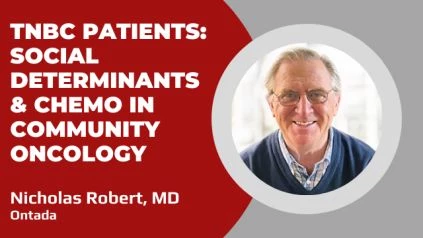Nicholas Robert, MD – Chief Medical Officer of Ontada
Nicholas J. Robert, the chief medical officer at Ontada, is responsible for enhancing the clinical focus and expertise of the organization, ensuring the highest scientific standards and clinical relevance in studies, real-world data offerings, and educational programs, building on his extensive experience as a practicing oncologist and his previous role as VP, Medical Affairs at Ontada overseeing the development of real-world evidence studies and consortium protocols.
Triple negative breast cancer (TNBC) is known to have a higher incidence in African American women compared to European American women and is associated with poorer outcomes. Multi-agent neoadjuvant chemotherapy (NC) is considered the standard of care for early-stage TNBC and has been shown to improve survival rates. Social determinants of health (SDOH), including race and socioeconomic status, have been identified as factors that can influence outcomes in TNBC patients. This study aimed to investigate whether SDOH measures affect the utilization of NC in early-stage TNBC patients.
The study conducted a retrospective observational cross-sectional analysis of patient data from The US Oncology Network. Using electronic health records (EHR) data from the iKnowMed system, the researchers identified patients diagnosed with TNBC between March 31, 2017, and September 30, 2021, with stages II-IIIB disease or tumor size ≥2cm (T2 or higher). The index date for each patient was set as the initial TNBC diagnosis, and the records were assessed from 6 months before to 6 months after diagnosis. The analysis focused on NC initiation, patient characteristics, and social determinants, including the Area Deprivation Index (ADI), which measures socioeconomic status.
A total of 3,321 TNBC patients were included in the study, with an average age of 58 years. Among the patients, 59% were White, 15% were Black, 3% were Asian, and 23% were categorized as other or unknown. Among these patients, 2,139 (64%) received neoadjuvant chemotherapy. The analysis revealed that patients who received NC were generally younger (mean age 55.9 vs. 61.8; p=0.001), had higher body mass index (BMI) values (70% with BMI>25 vs. ≤25; p=0.045), and had commercial or Medicaid insurance (67.5% with commercial insurance or Medicaid vs. 52.5% with Medicare; p=0.001). Regional differences were also observed, with a lower proportion of patients in the southern US census regions receiving neoadjuvant chemotherapy compared to the western regions. Additionally, there was no significant difference in NC use between Black and White patients (66% vs. 64%), and no significant disparities were found based on race, ethnicity, or ADI in the receipt of NC.
Based on the findings, the study concluded that there were no apparent inequities in the utilization of neoadjuvant chemotherapy among TNBC patients in the community oncology setting. The results suggested that the poorer outcomes observed in Black patients with TNBC may not be solely due to underutilization of neoadjuvant chemotherapy. While race, ethnicity, and socioeconomic status have been recognized as important factors in TNBC outcomes, this study did not find significant disparities in NC use associated with these social determinants. Further research is needed to explore additional factors that may contribute to the observed differences in outcomes among TNBC patients.

